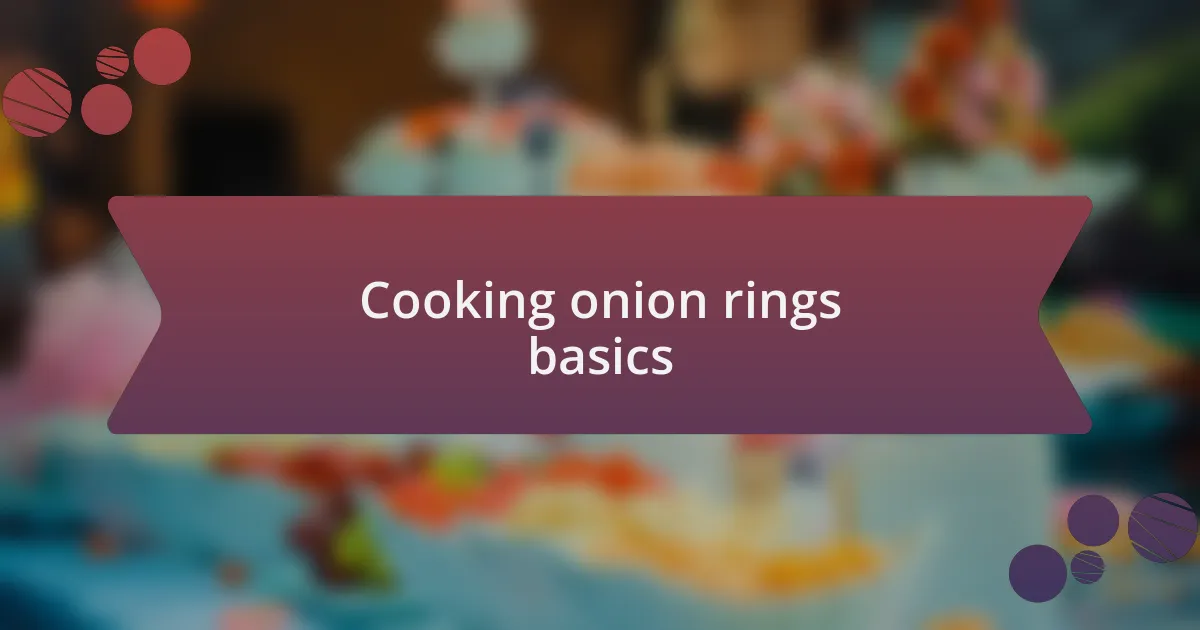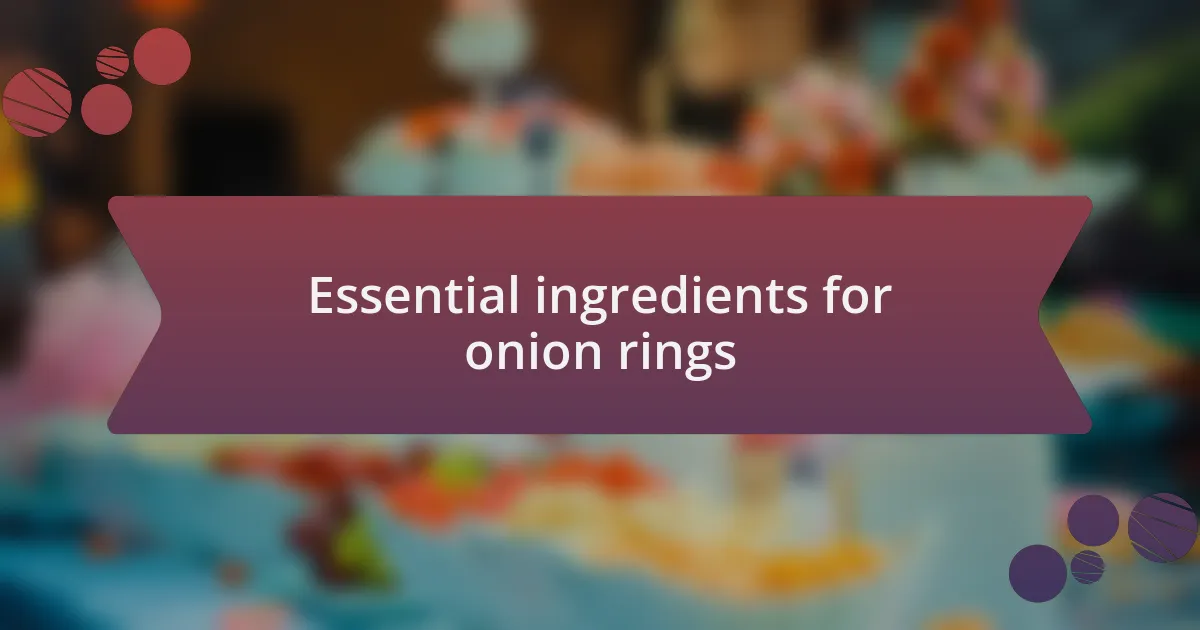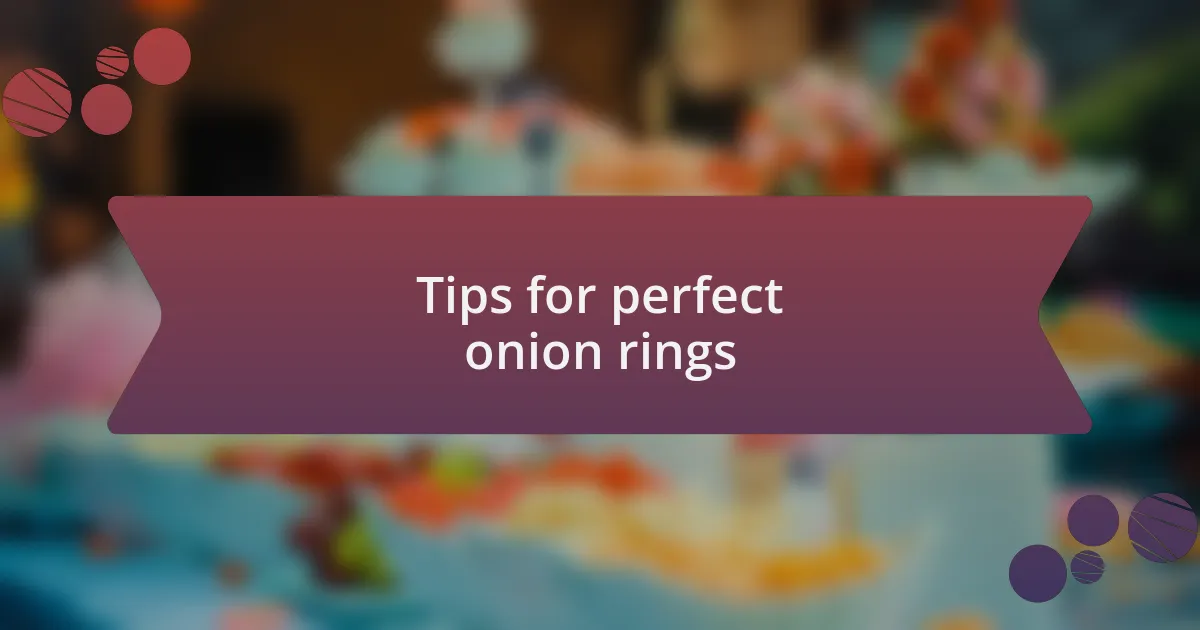Key takeaways:
- Choosing the right onion variety, such as sweet Vidalia or bold red onions, significantly impacts flavor and experience.
- The batter composition, including flour, cornstarch, and seasonings like paprika or garlic powder, is essential for achieving the desired crunch and taste.
- Maintaining the oil temperature between 350°F and 375°F is crucial to avoid greasy or burnt onion rings.
- Experimenting with different coatings and spices can elevate onion rings into unique and gourmet dishes.

Cooking onion rings basics
Cooking onion rings is truly a delightful experience. I remember the first time I attempted to make them; the aroma of sautéing onions filled my kitchen, instantly making it feel warm and inviting. The key is selecting the right type of onion; I personally prefer sweet onions, like Vidalia or Walla Walla, as they offer a perfect balance of flavor that complements the crispy coating.
Once you have your onions sliced, the magic begins with the batter. I’ve experimented with various mixtures, finding that a combination of flour, cornstarch, and a touch of seasoning creates that coveted crunch. Have you ever considered how the right batter can elevate a simple dish? It’s remarkable how a hint of paprika or cayenne pepper can transform the taste profile and make your onion rings unforgettable.
Frying them at the correct temperature is crucial too. When I first tried to fry them at too low of a heat, I ended up with soggy rings rather than the delightful crispy bites I had envisioned. The best advice? Invest in a candy thermometer or use the “drop a piece of bread” test. When it browns in about 60 seconds, you’re ready for frying. This little detail can be the game-changer that makes your onion rings the best you’ve ever made.

Essential ingredients for onion rings
To create the ideal onion rings, the first essential ingredient is, of course, the onion itself. I’ve found that experimenting with different varieties can yield surprises; while I often reach for sweet onions, I once tried sharp red onions in a pinch and was amazed by the bold flavor they brought to the dish. Have you ever thought about how the onion you choose can impact not just taste, but also the overall experience of biting into that crunchy exterior?
Next comes the batter, which is like the canvas for your onion rings. I remember the first time I made a beer batter; the carbonation added a lightness that made each bite feel almost ethereal. Mixing flour, cornstarch, and the right spices, like garlic powder and a hint of black pepper, creates a balance that elevates the rings. It’s fascinating how these simple ingredients can transform an ordinary onion into something magical, isn’t it?
Finally, let’s talk about seasoning! Adding just a pinch of salt can enhance the flavors dramatically. I’ve often tossed the freshly fried rings in a mix of salt and a sprinkle of cayenne for that extra kick. It’s these little tweaks that bring life to your onion rings and make them a standout dish at any gathering. What seasonings have you tried that have made your onion rings unforgettable?

Tips for perfect onion rings
When it comes to achieving that perfect crunch, the temperature of the oil is crucial. I’ve learned from experience that maintaining a steady heat between 350°F and 375°F is key. If the oil isn’t hot enough, the onion rings soak up too much grease, and if it’s too hot, they burn before cooking through. Isn’t it amazing how a simple adjustment in temperature can make or break your dish?
Consider using a double-dipping technique for extra crunch. I vividly remember the first time I coated my onion rings in flour, then soaked them in buttermilk, followed by another flour dredge. The result was like nothing I had experienced before: an ultra-crispy shell that made each bite a tantalizing crunch. Have you ever tried this method? It truly transforms the texture and keeps you coming back for more.
Lastly, don’t forget about resting your onion rings before serving. I’ve found that allowing them to rest on a wire rack for a few minutes after frying lets any excess oil drip off while maintaining their crispy finish. It’s a small step, but it makes such a difference! Have you ever noticed how quickly an over-greased onion ring can lose its appeal? A little patience can elevate your dish significantly.

Variations of onion rings
When it comes to onion rings, creativity can lead to some delightful variations. One of my personal favorites is adding spices to the batter. The first time I experimented by mixing in paprika and garlic powder, the flavor explosion was unforgettable. Have you ever thought about how a simple tweak can elevate a classic dish to something extraordinary?
Another fun variation I’ve tried is using different types of onions for varying flavor profiles. Sweet Vidalia onions create a milder taste, while red onions give a beautiful color and a sharper kick. It was a surprise for my friends when I presented them a platter of mixed onion rings—each bite sparked discussions about which they preferred. What’s your favorite kind of onion for frying?
And let’s not forget about the alternative coatings we can use! The first time I swapped traditional flour for panko breadcrumbs, I was astonished by the difference. The added texture brought a satisfying crunch that made the onion rings feel gourmet. Have you ever thought about experimenting with different coatings? It can turn an ordinary dish into a culinary adventure!